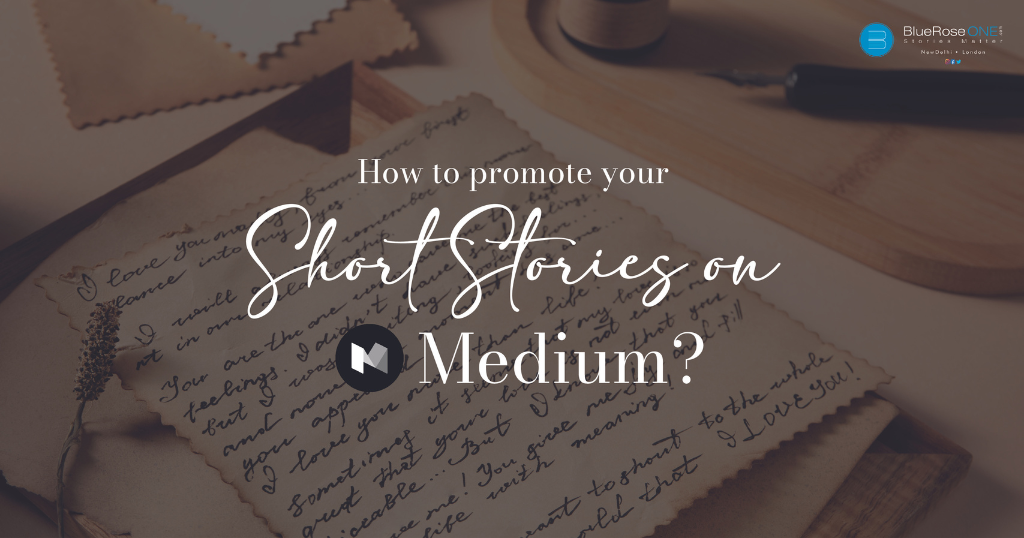
How to Promote Your Short Stories on Medium?
Are you an aspiring writer or an author looking to gain exposure for your short stories? Medium, a popular platform for writers, can be a valuable tool for promoting your literary works. With a vast readership and opportunities for writers to monetize their content, Medium offers a unique space for sharing your stories and attracting readers. Read: How to pick between Paperback, Hardcover, Ebook – What’s best for you? In this comprehensive guide, we will explore various strategies and tips on how to effectively promote your short stories on Medium, answering some frequently asked questions along the way. Can I promote my book on Medium? Absolutely! Medium is not limited to just articles and essays; it’s a versatile platform where writers can share a wide range of content, including book excerpts, promotional content, and short stories. Here’s how you can promote your book on Medium: You may also read: Top 10 Tony Ribbons Books That Inspire Success and Change How Do You Promote Content on Medium? To effectively promote your content on Medium, you need to understand the platform’s dynamics and utilise the following strategies: You may also like: Self-Publishing Successful stories: From Pub to Pages How Do I Get Media Attention for My Book? Getting media attention for your book can be a game-changer for your writing career. Here are some strategies to secure media coverage for your book: You may also like: Top 10 Best Leadership Books in Literature to Inspire Your Journey How Do You Go Viral on Medium? Going viral on Medium, like any other platform, is a combination of content quality, timing, and a bit of luck. Here are some strategies to increase your chances of going viral: You may also like: Romance Novel Complete Publishing Guide in 2024 Can you promote posts on Medium? Medium does not have a built-in advertising or promotion system like Facebook or Instagram. The platform primarily relies on organic reach and engagement to surface content for readers. However, you can promote your posts indirectly by following the strategies mentioned earlier. Engaging with trending topics, optimising your profile, and collaborating with publications are effective ways to increase your content’s visibility and reach a broader audience. Read: Facebook Book Marketing: 7 Steps on How to Promote Your Book on Facebook In conclusion, promoting your short stories on Medium involves a combination of high-quality content creation, engagement with readers, and strategic outreach. By utilising the platform’s features effectively and following the tips provided in this guide, you can increase your visibility and attract a dedicated readership to your work. Don’t forget to adapt your strategies to the ever-evolving landscape of online writing and publishing.
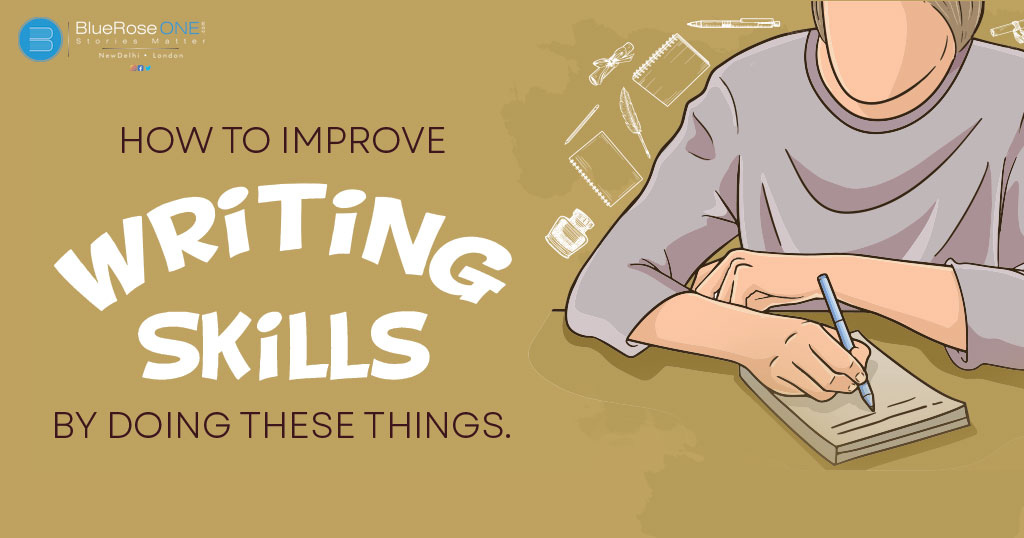
Learn how to improve writing skills by doing these simple things
In a world where effective communication is paramount, strong writing skills have become increasingly crucial. Whether you’re a student aiming to improve your academic writing or a professional striving to write more effectively in the workplace, there are several strategies you can employ to boost your writing prowess. Read: A Complete Guide on How to Make Your Book an International Bestseller. In this comprehensive guide, we will explore various techniques and practices that will help you refine your writing skills, including improving your handwriting, enhancing content writing skills, and developing overall writing and reading abilities. Understanding the Importance of Strong Writing Skills Before diving into the strategies for enhancing your writing skills, it’s crucial to understand why having excellent writing abilities is essential. Strong writing skills are not only valuable for academic and professional success but also for effective communication in everyday life. Whether you’re writing an essay, crafting a report, composing emails, or simply conveying your thoughts in a clear and concise manner, proficient writing skills can make a significant difference. Here’s a breakdown of various facets of writing skills and how to improve them: You may also like: The importance of professional editing in self publishing Enhancing your writing skills is a journey that requires dedication, practice, and continuous learning. By following the strategies outlined above, you can improve your handwriting, elevate your content writing abilities, develop stronger writing skills in English, and boost your overall writing and reading competence. Read: How to pick between Paperback, Hardcover, Ebook – What’s best for you? Remember that improvement takes time, so be patient with yourself and stay committed to your writing goals. Whether you’re a student, professional, or simply someone looking to become a more effective communicator, these skills will serve you well in all areas of life.
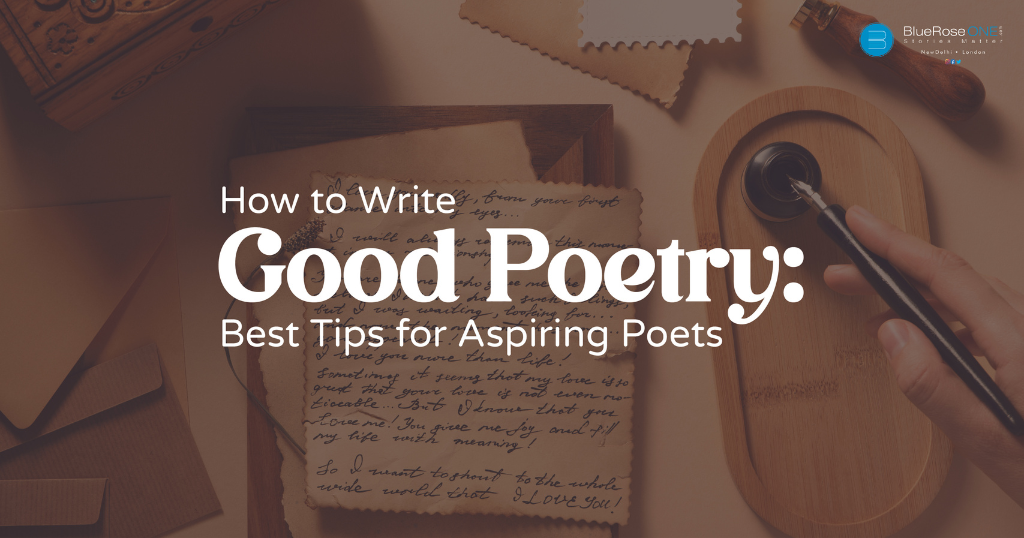
How to Write Good Poetry: The Best Tips for Aspiring Poets
Poetry is a strong form of self-expression as well as an engaging means of communicating emotions, tales, and ideas. Crafting good poetry can be an enormously satisfying experience, whether you’re an aspiring poet or simply someone who wants to dip their toes into the world of rhyme. Read: A Complete Guide on How to Make Your Book an International Bestseller. This blog will go through vital ideas and insights for writing appealing and memorable poems. We’ll also discuss what constitutes a “good” poetry and share some of the finest poems ever written. Let’s Understand What Makes a Good Poem. Poetry is a profound and powerful kind of art that has the capacity to influence people, to change their perspective on the world, and to elicit a broad variety of emotions. It is a meticulously woven tapestry of emotions, visuals, and distinct viewpoints that may make a lasting impression on its readers. In this investigation of what constitutes a good poem, we will dig into the main characteristics that distinguish great poems and support these findings with examples to demonstrate their significance. Emotional Depth: The Heartbeat of Poetry Poetry’s heartbeat is emotional depth. A excellent poetry delves deeply into the human experience, eliciting real and authentic emotions in readers. It invites people to experience the poems’ passion, grief, pleasure, or sadness. Consider the following example from Maya Angelou’s poem, “Caged Bird”: “But a caged bird stands on the grave of dreams his shadow shouts on a nightmare scream his wings are clipped and his feet are tied so he opens his throat to sing.” In these lines, Angelou vividly portrays the emotional depth of the caged bird’s experience, capturing the reader’s empathy and imagination. The raw emotions of confinement and longing are palpable, making it a powerful and emotionally resonant poem. You may also like: Amazon Ads for Authors: A Step-by-Step Guide to Boosting Book Sales Imagery: Painting Pictures with Words Poets use imagery like a paintbrush to create masterpieces, painting vivid pictures in the imaginations of their readers. Evocative imagery is used in good poetry to transport the audience into the environment being represented. The use of appropriate imagery not only makes the poetry memorable, but it also enhances the reader’s experience. Let’s look at a stanza from William Wordsworth’s “I Wandered Lonely as a Cloud”: “Continuous as the stars that shine And twinkle on the milky way, They stretched in never-ending line Along the margin of a bay.” Wordsworth’s use of simile and metaphor helps readers visualize the daffodils as a shimmering, endless sea of golden stars. This imagery turns a simple scene into a vivid and enchanting landscape in the reader’s mind, making the poem come alive. Unique Perspective: Seeing the Familiar Anew A good poem offers a fresh viewpoint or unique insight into a familiar topic. It encourages readers to see the world differently and challenges their preconceptions. A perfect example of this is Emily Dickinson’s poem, “Because I could not stop for Death”: “Because I could not stop for Death – He kindly stopped for me – The Carriage held but just Ourselves – And Immortality.” Dickinson’s exploration of death as a gentle and courteous guide is a unique perspective that defies the conventional portrayal of death as a grim and fearsome force. This poem prompts readers to contemplate the concept of mortality from a fresh and thought-provoking angle. You may also like: How to Publish a Book? | Publish Your Book | BlueRoseOne Unity of Form and Content: The Symphony of Poetry A excellent poetry typically achieves a seamless unity of form and substance, in addition to the three qualities described above. This means that the form of a poem, as well as the poetic techniques used, should be in sync with its content and emotional depth. Consider T.S. Eliot’s “The Love Song of J. Alfred Prufrock”: “Let us go then, you and I, When the evening is spread out against the sky Like a patient etherized upon a table.” Eliot’s use of the metaphor “like a patient etherized upon a table” not only creates vivid imagery but also mirrors the numbness and paralysis of the speaker’s emotional state. The form and content work together to enhance the poem’s impact, creating a powerful and unified artistic expression. Sound and Rhythm: The Music of Language While rhyme and rhythm aren’t the sole determinants of a poem’s quality, they play significant role in creating the musicality of language. Sound and rhythm can elevate a poem’s emotional impact and contribute to its memorability. An example of this can be found in Robert Frost’s “Stopping by Woods on a Snowy Evening”: “Whose woods these are I think I know. His house is in the village though; He will not see me stopping here To watch his woods fill up with snow.” Frost’s use of rhyme and meter not only imparts a musical quality to the poem but also mirrors the sense of quiet and stillness in the winter landscape. The sound and rhythm of the poem enhance its overall beauty and resonance. Simplicity and Clarity: The Power of Conciseness While the use of complex and abstract language can have its place in poetry, simplicity and clarity are equally powerful. Good poems often distill complex emotions and ideas into clear and concise language that is easily understood. Take Langston Hughes’ “The Negro Speaks of Rivers” as an example: “I’ve known rivers: I’ve known rivers ancient as the world and older than the flow of human blood in human veins.” Hughes communicates a profound sense of history and heritage with simple language. The clarity and directness of his words make the poem accessible to a wide audience while maintaining its emotional depth. Read: How Can I Get a Book Published? Here’s a list of Best Tips on How to Write a Great Poem Now, let’s dive into practical tips for crafting excellent poetr The Best Blank Verse Poems Ever Written “Blank verse” refers to unrhymed lines of poetry, typically in…
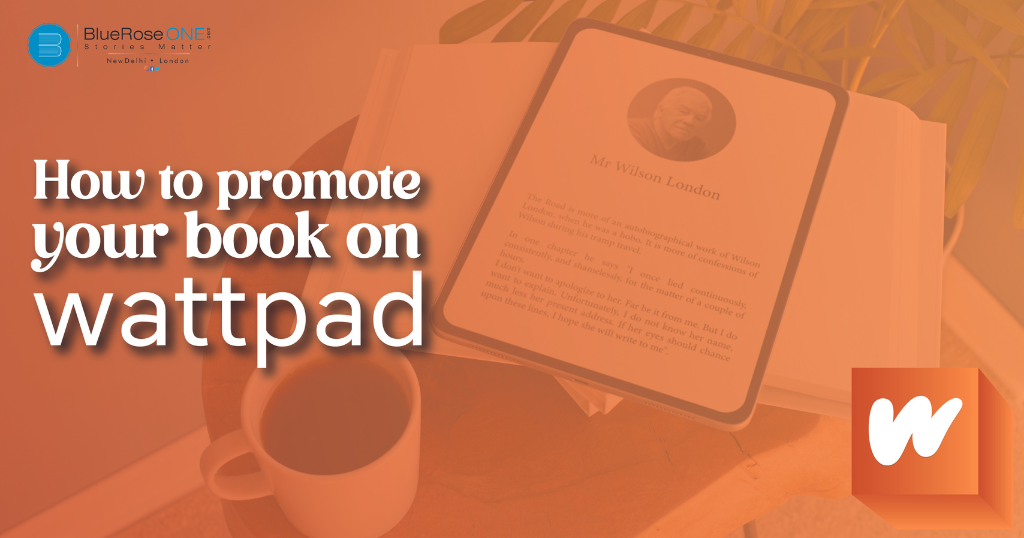
How to promote your book on Wattpad?
The digital age has revolutionised the way we consume literature, with platforms like Wattpad paving the way for aspiring writers to showcase their talent to a global audience. Wattpad, a treasure trove of stories and novels, offers writers the opportunity to share their work, build a readership, and even gain recognition in the publishing world. Read: Kobo vs. BlueRoseONE vs. Kindle: Which is the most suitable eBook reader for you? If you’re an author seeking to promote your book on Wattpad, you’re on the right track. In this blog, we’ll explore the ins and outs of Wattpad promotion, from its perks to strategies that can help you rise to prominence. Let’s dive into the world of Wattpad and unveil the secrets of success. What is the History of Wattpad Wattpad is a social storytelling platform that has revolutionised the way people consume and create literature. Founded in 2006 by Allen Lau and Ivan Yuen, Wattpad started as a small startup that aimed to harness the power of mobile technology. Its founders recognised the potential of cell phones to become a medium for storytelling. They envisioned a platform that would allow users to access stories on their mobile devices, whether they were waiting for a bus or taking a coffee break. In 2006, the first version of Wattpad was launched, providing a space for writers to share their work with a potentially vast audience of mobile users. The platform’s early focus was on mobile reading, and it quickly gained popularity among those who embraced this new way of consuming literature. As Wattpad continued to grow, it evolved into a social platform for writers and readers. Users could not only read stories but also write and share their own. The introduction of the Writer’s Portal in 2009 allowed authors to publish their works directly on the platform, opening the doors to a flood of new content. One of the defining features of Wattpad is its interactive nature. Readers can leave comments, offer feedback, and engage with authors, creating a unique and dynamic reading experience. Writers can connect with their audience and receive real-time responses, which is a departure from the traditional publishing process. Over the years, Wattpad’s success grew exponentially. It attracted millions of users and an ever-expanding library of stories across various genres, from romance to science fiction. The platform became a breeding ground for emerging authors, and some of them achieved remarkable success. Notable works like “The Kissing Booth” by Beth Reekles and “After” by Anna Todd originated on Wattpad and later made their way to traditional publishing and even film adaptations. Wattpad’s impact on the literary world was undeniable. Its user-generated content and democratised publishing model challenged traditional publishing houses and brought diverse voices and stories to the forefront. As a result, in 2019, Wattpad announced its publishing division, Wattpad Books, which aimed to bring Wattpad stories to bookshelves worldwide. In 2021, South Korean technology company Naver acquired Wattpad, merging it with another web novel platform, Webnovel. This merger has expanded Wattpad’s reach and resources, further transforming the landscape of storytelling. You may also read: Top 10+ Must-Read Books for Teens in 2025 Understanding the Wattpad Landscape Before we go into the tactics, let’s first grasp what Wattpad is all about. Wattpad is a social storytelling platform where writers can post their work, engage with readers, and build a fan following. It’s a growing digital collection of stories ranging from romance and fantasy to mystery and science fiction. Wattpad, which has millions of users worldwide, provides a dynamic environment for writers and readers to communicate. How much do Wattpad writers get paid? One of the most commonly asked questions on Wattpad is whether writers are compensated for their work on the platform. Wattpad Stars is a programme for chosen writers on Wattpad. This application allows you to make money by having advertisements shown alongside your articles. While the pay isn’t spectacular, it’s a step towards monetizing your content. To be considered for the Wattpad Stars Programme, your tale must have a large viewership, often in the thousands of reads. The more people who read your story, the more likely you are to be invited to join the course. Is it worth it to publish a book on Wattpad? The advantage of having your novel published on Wattpad extends beyond monetary gain. Wattpad gives you a platform for exposure, a location where people from all around the world may find your work. While the financial advantages may be minimal, the potential to establish a loyal following is priceless. Many Wattpad authors have moved on to traditional publishing, using their online popularity. Furthermore, writing on Wattpad lets you receive comments from your readers in real time. This direct interaction might help you improve your writing style and gain a better understanding of your target audience. It’s an excellent place to put your stories to the test. How Long Does It Take to Get Famous on Wattpad? The path to stardom on Wattpad might differ greatly across writers. Some authors attain fame in a matter of months, while others may take years. The goal is to constantly create high-quality content, interact with your readers, and promote your work outside of Wattpad. Building a readership takes time, but you must be patient and dedicated to your trade. A sequence of pieces or novels that gather traction and push a writer to popularity is common. Interact with your readers, thank them for their help, and listen to their ideas. In the internet arena, word of mouth may be a strong instrument. Does Wattpad pay you in India? Yes, writers in India may participate in Wattpad’s earnings scheme. While the site may have its own payment procedures and levels, writers from India can take advantage of the Wattpad Stars Programme and get compensated for their work. Does Wattpad pay on a monthly basis? Wattpad usually compensates its writers once a month. Once you’ve joined the Wattpad Stars Programme and your stories have advertisements running,…
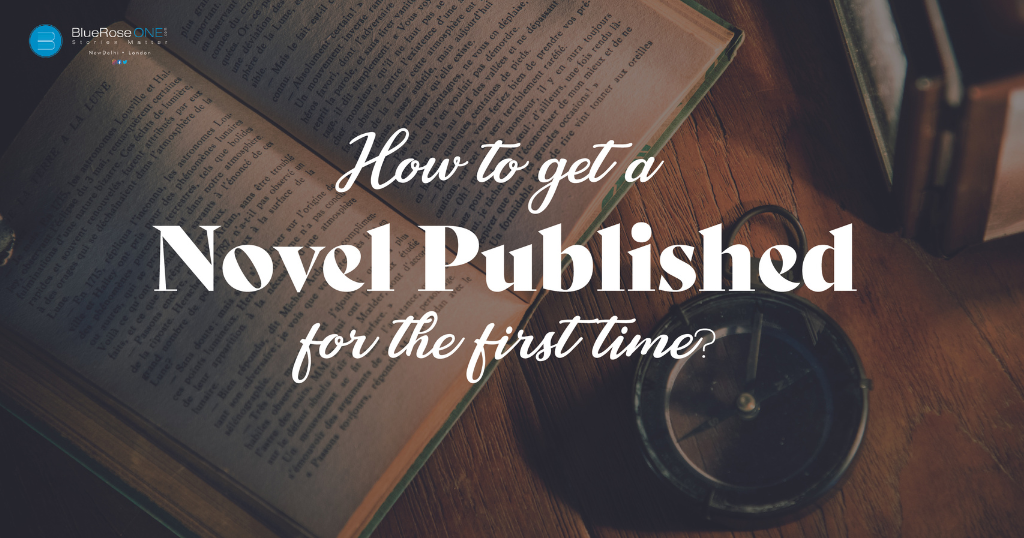
How to Get Your First Novel Published: Tips and Options
Getting your first novel published is a thrilling endeavour, but it can also be a challenging one. In this blog post, we will explore various methods for achieving your dream of becoming a published author. Whether you’re looking to publish your novel for free or are willing to invest some money, there are options available. We will also delve into the costs associated with publishing and provide tips for aspiring authors. Let’s embark on this literary journey together. Traditional Publishing vs. Self-Publishing The first decision to make when you want to publish your novel is whether to pursue traditional publishing or self-publishing. Each approach has its pros and cons. 1. Traditional Publishing: Traditional publishing involves submitting your manuscript to literary agents or publishers. Here are some steps to follow: 2. Self-Publishing: Self-publishing is a quicker and more accessible route, but it requires more self-promotion. Key steps include: You may also like: Unlocking success: Bluerose publisher’s best Amazon KDP books What is the Cost of Publishing a Novel? Publishing a novel, whether traditionally or independently, can be a costly endeavor. The expenses can vary significantly. Traditional publishing typically doesn’t require upfront fees, but it often involves giving up a portion of your royalties to the publisher. In contrast, self-publishing allows you to maintain creative control but comes with expenses such as editing, cover design, and formatting. For those seeking free publishing options, there are platforms like Wattpad and Medium where you can share your work online for free. While these platforms don’t cost money, they may not offer the same level of exposure as traditional publishing or self-publishing through reputable channels. How to Publish Your Novel for Free? If you’re determined to publish your novel for free, there are a few routes you can take: You may also like: Is kindle direct publishing right for your next book? What is the Minimum Cost to Publish a Book/Novel in 2023? If you’re open to investing a modest amount in publishing your novel, consider these essential expenses: Earnings from First Novels As you gather more books in your backlist, establish a fanbase, and engage in successful marketing tactics, your earning potential improves. Many self-published authors have seen their revenue grow steadily over time, sometimes reaching full-time author status. Publishing your first novel is a thrilling adventure full of possibilities. Whether you choose traditional publication or self-publishing, remember that perseverance, drive, and a well-crafted tale are essential. While free publication of your manuscript is a possibility, it may not deliver the visibility or cash you seek. Read: 15 Latest Marketing Trends to Promote Your Book in 2023. The decision to publish your work ultimately comes down to your goals, finances, and dedication to your art. If you stay committed to your writing, your goal of being a published author can come true. Publish your book with BlueRoseONE and become a bestselling author. Don’t let your dream of becoming an author fade away, grab the opportunity now and publish your book – be it fiction, non fiction, poetry or more.
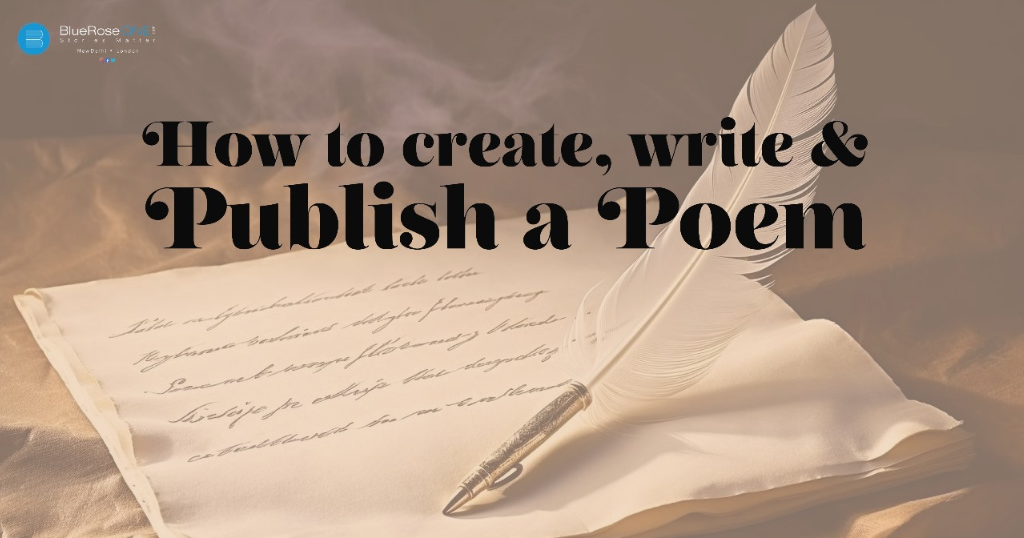
Learn How to Create, Write, and Publish a Poem
Poetry has a timeless charm due to its ability to capture emotions, conjure images, and express deep concepts with simple words. If you love poetry and want to share your rhymes with the world, this book will teach you how to design, compose, and publish your own poems. Read: How to Write and Create a Compelling Book Blurb We’ll take you through the interesting world of poetry, from writing poems to having your work published, in this blog. Can you publish a single poem? You certainly can! Individual poetry submissions are accepted by several print and online magazines. These sites enable young poets to present their work to a larger audience. Open requests for poetry contributions are common in literary publications, journals, and anthologies. To begin, polish your poetry till it shines, and then look for magazines that fit your style and topic. Create an engaging cover letter, follow the submission requirements, and submit your poem for consideration. You may also like: What Is Contemporary Fiction? Definition, Themes with Examples How Do I Publish My Own Poetry? Publishing your poetry can take several forms, depending on your goals and resources: You may also like: Literary Fiction vs. Genre Fiction: Definition & Examples How Much Does It Cost to Publish Poetry? The cost of publishing poetry varies depending on the publishing path you choose. Here’s a breakdown: You may also like: Top 10 Rhetorical Devices Every Writer Should Know How Do You Publish a Poem for Free? Publishing your poem for free is achievable through various online platforms and competitions. Here are some ways to get your poetry out there without spending: You may also like: What is Ghostwriting? A Complete Guide for Beginners How Do You Publish a Poem Online? Publishing poetry online is relatively straightforward. You may also like: 10 Magical Books That Combine Christmas and Fantasy How Do You Get a Poem Published? To increase your chances of getting a poem published, follow these steps: You may also like: How to Publish a Book? | Publish Your Book | BlueRoseOne How Do I Get a Poem Published? Getting a poem published often requires patience and persistence. Here’s a summarised approach: In conclusion, poetry offers a unique channel for self-expression, and publishing your poems allows you to share your creativity with the world. Whether you opt for traditional publishing, self-publishing, or sharing your work online, remember that persistence, dedication, and continuous improvement are key to success in the world of poetry. Read: How to pick between Paperback, Hardcover, Ebook – What’s best for you? Embrace the joy of writing and sharing your verses, for poetry has the power to touch hearts and souls in profound ways. Publish your book with BlueRoseONE and become a bestselling author. Don’t let your dream of becoming an author fade away, grab the opportunity now and publish your book – be it fiction, non fiction, poetry or more.
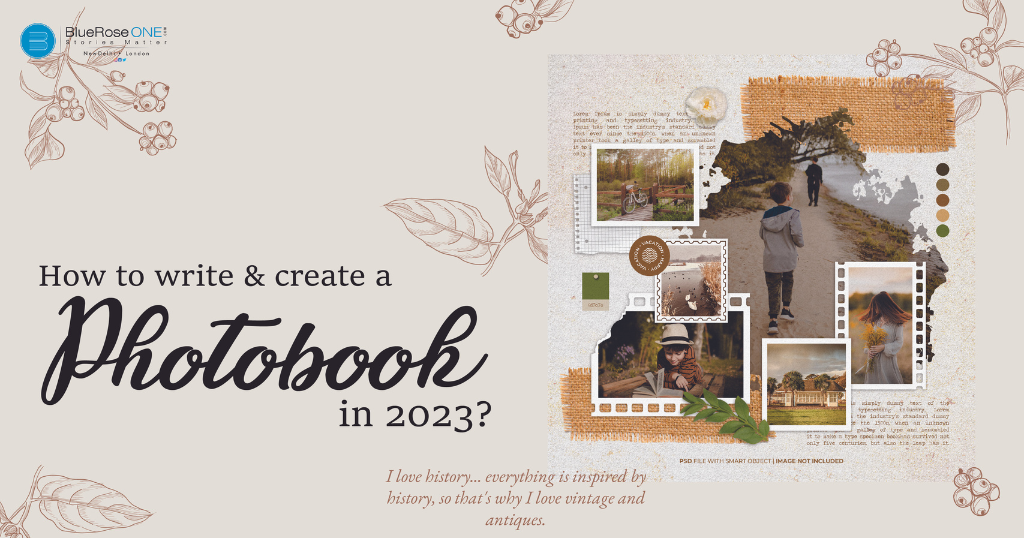
How to write and create a photobook in 2024
Photos have become an essential part of our lives in the digital era, documenting memories, experiences, and cherished moments. What better way to keep and share these memories than to make a beautiful photobook? This article will walk you through the process of producing a customised photobook in 2024, whether you’re a novice or trying to improve your photobook-making abilities. Read: How to Write an Engaging Introduction for Your Book: Tips and Examples We’ll cover everything you need to know to turn your digital and printed images into beautiful mementos, from choosing the best photos to designing layouts and adding text. How Do I Make a Photobook for Beginners? Creating a photobook is a creative and rewarding endeavour, even if you’re a beginner. Here are the essential steps to get you started: Can I Make My Own Picture Book? Absolutely! Making your own picture book is a creative project that allows you to tell a story or showcase your artwork and photography. Whether you’re a parent creating a children’s picture book, an artist displaying your portfolio, or someone wanting to share a collection of illustrations, you can follow a similar process to creating a photobook: How to Make a Book with Photos and Text Creating a book with photos and text combines storytelling and visual elements to convey your message effectively. Whether you’re crafting a family history book, a travel journal, or a cookbook, here’s how to do it: How to Make a Photo Book Online Creating a photo book online is a convenient and user-friendly option. Follow these steps to make your photo book: In 2024, making a picture book is a fantastic way to preserve memories, tell tales, and demonstrate your talent. Whether you’re a novice or an expert, the process requires careful planning, deliberate design, and attention to detail. Read: What is Typesetting: A Complete Guide to its Uses, Definition, and Importance You may create customised picture books that capture the spirit of your beloved memories and experiences by picking the correct photographs, combining them with complimentary text, and using internet platforms or DIY approaches. So grab your camera or go through your digital archives and start turning your photographs into lovely mementos.
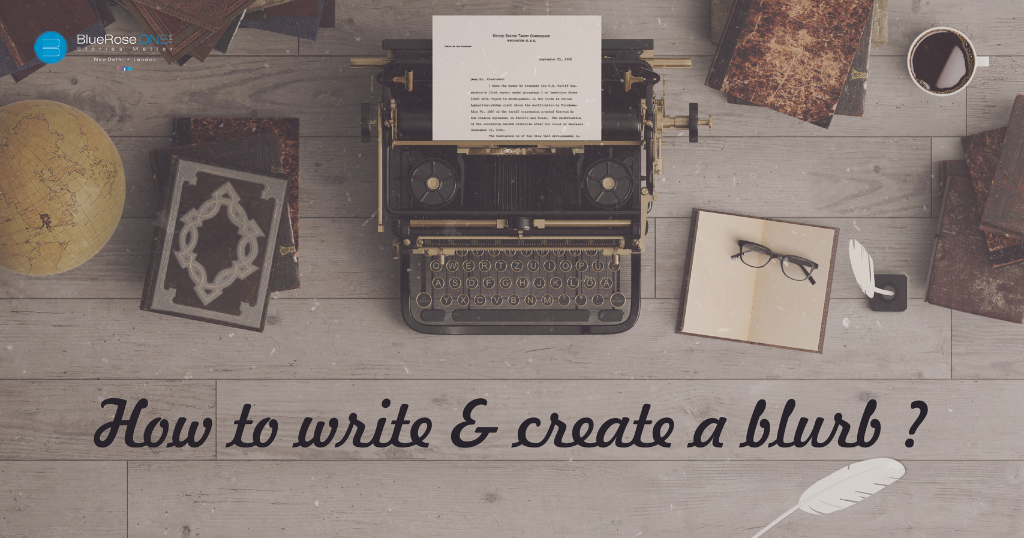
How to Write and Create a Compelling Book Blurb
The blurb for a book is similar to the teaser trailer for a movie, providing a tantalising insight into the world of the tale and compelling readers to read on. Writing a good blurb is an important talent for both authors and publishers. This blog will walk you through the process of creating an engaging book blurb, whether you’re a fledgling novelist, a self-published author, or just someone inquisitive about the art of blurb writing. We’ll define a book blurb, show samples, and offer practical advice on how to write an engaging blurb that entices people to read on. What is a book blurb? A book blurb is a quick, interesting overview of the content of a book that can be found on the back cover or inside flap of a physical book or on the product description page of an online listing. Its major goal is to capture the reader’s attention, pique their curiosity, and give them an idea of what to expect from the book. A well-written blurb delivers enough intrigue and information to pique the interest of potential readers without giving too much of the narrative away. It’s a marketing technique, a sales pitch, and a promise of the adventure or information contained within the pages. What is a Book Blurb Example? Here’s an example of a book blurb for a mystery novel: “In the dimly lit alleys of Victorian London, a brilliant detective races against time to solve a series of gruesome murders. But as the bodies pile up and the clock ticks down, the line between hunter and hunted blurs. In this gripping tale of suspense and intrigue, follow Detective James Winters on a chilling journey through the dark underbelly of the city, where secrets and shadows reign supreme. Can he unravel the mystery before the killer strikes again? Prepare for a riveting adventure that will keep you guessing until the final page.” You may also like: What is Typesetting? A Beginner’s Guide to Perfect Page Layouts How Do I Write a Blurb for My Book? Writing a compelling book blurb requires a mix of creativity and marketing savvy. Here’s a step-by-step guide to help you craft an enticing blurb: You may also like: What is Typesetting? A Beginner’s Guide to Perfect Page Layouts Who Writes the Blurb of a Book? Because the author is intimately familiar with their own work, they are usually in charge of drafting the first draught of the book blurb. In the conventional publishing sector, however, a professional editor, marketer, or publisher would often cooperate with the author on the blurb. Self-published writers can also hire a professional blurb writer or editor to guarantee that their blurb is as successful as possible. The ultimate objective is to write a blurb that successfully expresses the substance of the book while also engaging potential readers. How long does a blurb book take? The amount of time needed to create a book blurb varies based on factors such as the intricacy of the tale, the author’s experience with blurb writing, and the degree of information requested. In some circumstances, authors may spend only a few hours producing the perfect blurb, while in others, it may take many days or even weeks. It’s critical not to hurry the process because a well-written blurb is an important marketing tool for your book. Take the time necessary to ensure that it properly expresses the core of your work while also engaging your target audience. What Is the Difference Between a Book Description and a Blurb? A blurb and a book description serve similar functions but differ in context and length. A book description is a lengthy piece of promotional prose that is often featured on a book’s product page or in marketing materials. It gives a detailed description of the storyline, topics, and characters in the novel. A blurb, on the other hand, is a shorter, more condensed synopsis featured on the book’s cover or back cover, aiming to capture the reader’s attention immediately. While both are intended to lure readers, a blurb is more succinct and teaser-like, whilst a book description provides a more in-depth analysis of the book’s content. Why is a Blurb Important? A blurb is important for several compelling reasons: In conclusion, a blurb is a strong tool for attracting people, stimulating curiosity, and finally encouraging them to read your book. It is an important part of efficient book promotion and may have a big impact on the success of your literary work.
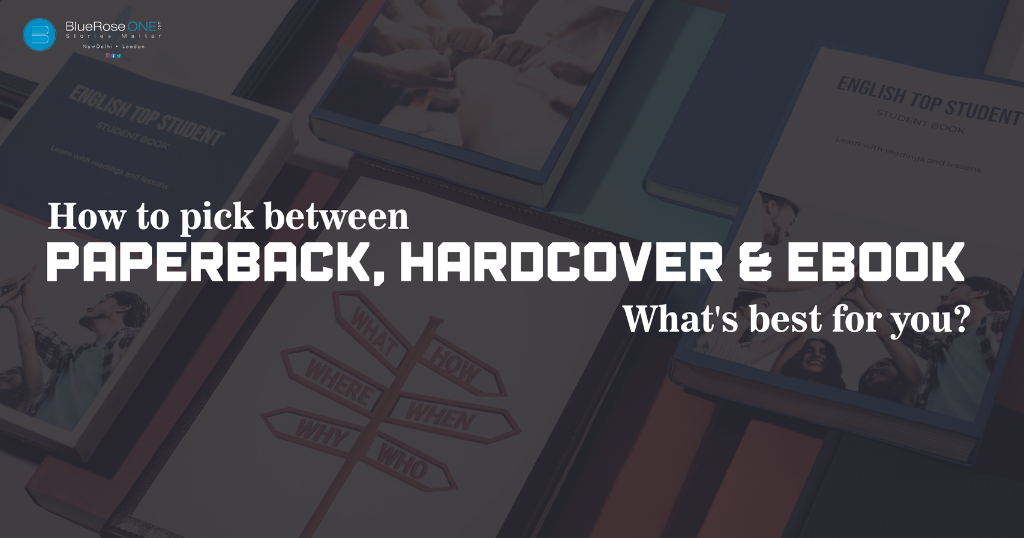
Paperback, Hardcover, Ebook – What’s best for you?
When it comes to reading a decent book, one of the first choices you’ll have to make is the format. Should you choose a paperback for its classic appeal, a hardcover for its durability, or an ebook for its digital convenience? Each alternative has its own distinct advantages, and the best one is primarily determined by your particular tastes and reading patterns. In this blog article, we’ll look at the benefits and drawbacks of paperback, hardcover, and digital formats. We’ll also answer frequently asked topics like whether paperbacks and ebooks are the same and why ebooks are typically cheaper. By the end, you’ll have a better idea of which format is ideal for you. You may also like: Amazon Ads for Authors: A Step-by-Step Guide to Boosting Book Sales Paperback vs. Hardcover Paperback Books: For ardent readers, paperbacks are a classic choice. They are lightweight and portable, with flexible spines that allow for pleasant reading. Furthermore, they are often less expensive than hardcovers. Paperback books are ideal for readers that value mobility, affordability, and a comfortable reading experience. They are great for daily reading, whether commuting or relaxing at home. Hardcover Books: Hardcovers, on the other hand, exude sophistication and durability. They are well-made and look great on bookshelves. Hardcovers are less prone to wear and tear due to their sturdy cover and high-quality paper. They are frequently the favoured choice for collectors, people seeking unique editions, or when a book must survive for generations. While hardcovers tend to be more expensive, they offer a timeless appeal and a sense of permanence. Which is better: paperback or ebook? The choice between paperback and ebook ultimately depends on your reading preferences. Here are some key factors to consider: You may also like: How to Publish a Book? | Publish Your Book | BlueRoseOne Are paperbacks and e-books the same? No, paperbacks and ebooks are not the same. While both provide access to the same content, they offer distinct reading experiences. Paperbacks provide a tactile feel and the joy of flipping physical pages, while ebooks offer digital convenience with features like adjustable text size, in-book searching, and the ability to highlight text. Ebooks are also more portable, as you can carry an entire library on a single device. Additionally, ebooks often come with interactive features like hyperlinks and multimedia elements, adding a new dimension to the reading experience. Why is an ebook cheaper than a paperback? Ebooks are typically cheaper than paperbacks due to several factors. First, there are no printing, paper, or shipping costs associated with ebooks. Second, ebooks don’t require physical shelf space in bookstores or warehouses, reducing overhead expenses. Publishers can pass these cost savings on to consumers. Furthermore, ebooks are subject to lower or no sales taxes in many regions. However, it’s essential to consider the initial cost of an e-reader device, as it can affect the overall affordability of ebooks. You may also like: How Can I Get a Book Published? How to Compare and Contrast Ebooks and Textbooks? When comparing ebooks to printed books, consider the following: You may also read: List of Top 10 Famous Ravinder Singh Books of All Time Difference Between Ebook and Printed Book Aspect Ebooks Printed Books Format Digital files viewed on electronic devices Physical books made of paper and a cover Portability Extremely portable; entire library in one device Less portable; carry limited books at a time Adjustable Text Size Adjustable font size for customized reading Fixed font size determined by the book’s printing Searchability Easily searchable for specific content No built-in search function; use a physical index Tactile Experience No tactile sensation; screen interaction Offers a tactile experience with paper and pages Ownership Digital rights; limited sense of ownership Tangible ownership with a physical copy Cost Often cheaper, with free and discounted options Paperback usually more affordable than hardcovers Environmental Impact Generally eco-friendlier due to no paper production Involves paper production, contributing to waste Collectibility Limited collectibility value in digital form Potential collectible value for rare editions Shelf Space Requires no physical shelf space Requires shelf or storage space Availability Instant downloads with wide online availability Availability depends on local bookstores and stock Choosing between paperback, hardcover, and ebook formats is a matter of personal preference and reading habits. Consider factors like portability, cost, and the tactile experience you prefer. Whether you opt for the traditional charm of a printed book, the durability of a hardcover, or the digital convenience of an ebook, what matters most is the joy of reading and the stories you encounter along the way.
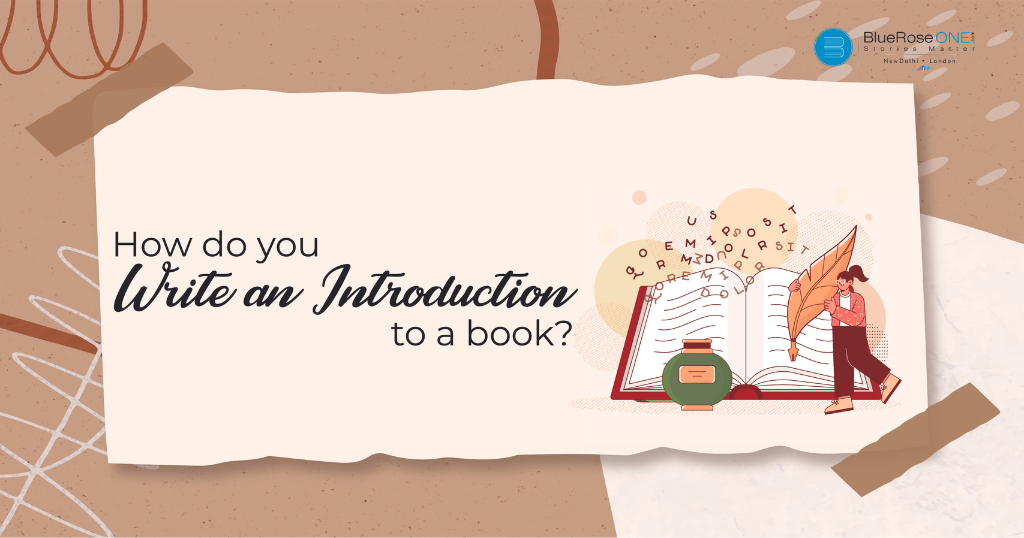
How to Write an Engaging Introduction for Your Book: Tips and Examples
The book’s introduction is your literary handshake with the reader; it’s like a blind date set up by an unknown entity—your chance to make a lasting first impression. It acts as a portal into the world you’ve built, inviting readers to enter and embark on the adventure you’ve designed. Read: 15 Easy Hacks to Inspire Yourself to Write a Book and Get it Published Easily But how can you write an opening that captivates your audience while also setting the tone for the rest of the story? In this article, we’ll look at the art of introduction writing, present examples, and address frequently asked questions to help you write an introduction that will leave an impression on your readers. What is an introduction to a book? Before delving into the intricacies of writing a compelling book introduction, let’s define what it is. An introduction in a book serves several crucial purposes: You may also like: How to Design a Book Back Cover in 5 Simple Steps How Do You Start a Good Introduction for a Book? You may also like: How to Publish My Book | Self Publish Your Book | BlueRoseOne How Do You Introduce a Book in a Paragraph? A concise yet impactful introduction can often be encapsulated in a single paragraph. Here’s an example of an introductory paragraph: “A shadowy figure emerges from the fog in the dimly lit streets of Victorian London, shrouded in mystery and driven by an insatiable thirst for justice.” This is the world of ‘The Enigmatic Detective,’ where danger lurks around every corner. We’ll uncover the mysteries of a city beset by crime and corruption as we dig into the life of Detective Alexander Blackwood. But there is a deeper mystery behind the gaslit lanes and cobblestone streets—the enigma of the investigator himself.” This paragraph performs three important introduction tasks: it establishes the setting (Victorian London), introduces the primary character (Detective Alexander Blackwood), develops conflict (crime and corruption), and generates interest (the detective’s riddle). You may also like: Fatal Flaw: Definition, Types, Example and More What is an Introduction to a Book for Kids? Introductions for children’s books should be engaging and age-appropriate. Consider using vibrant imagery, playful language, and relatable characters to draw young readers into the story. Here’s an example from a children’s book: “Once upon a time in a not-too-distant land, there lived a curious little squirrel named Sammy.” Sammy’s fluffy tail wiggled with delight as he embarked on a journey unlike any other. Join Sammy as he explores the enchanted forest, makes new friends, and sets out on a journey to defend his home from a nefarious gnome.” The opening in this example introduces the main character (Sammy the squirrel), the environment (an enchanted woodland), and teases the adventure and difficulty Sammy will experience. You may also like: How to Publish a Book? | Publish Your Book | BlueRoseOne Is the preface and introduction the same? No, the preface and introduction are not the same. They serve different purposes in a book: You may also read: Scion of Ikshvaku by Amish Tripathi: Book Review What is another word for the introduction of a book? While “introduction” is the most common term, you may also come across these synonyms or related terms: What is the introduction section of a book? The introductory portion of a book includes the first few pages or chapters that act as the introduction to the tale. Depending on the intricacy of the book, it might range from a single introduction paragraph to multiple chapters. This part lays the groundwork for the story, introduces characters or themes, and entices readers to keep reading. Read: Learn How to Publish Mystery Novels: A Complete Fiction Genre Guide In its simplest form, crafting an engaging start for your book entails developing a hook, setting the scene, introducing characters or themes, and creating curiosity. It’s your chance to establish a lasting first impression and inspire readers to go further into your creative universe. Whether you’re writing a novel, a nonfiction piece, or a children’s book, mastering this technique may enhance your narrative and link you with your audience from the start.
